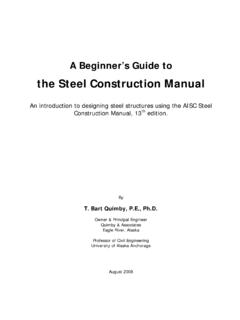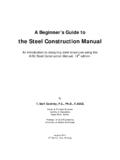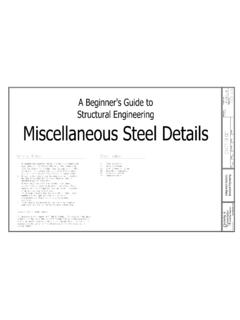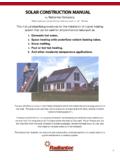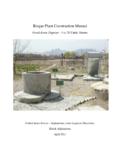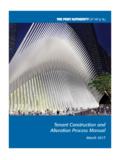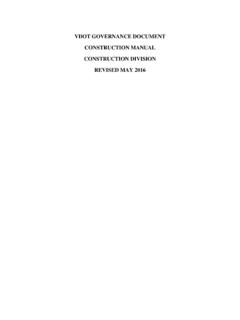Transcription of the Steel Construction Manual - B G Structural Engineering
1 A Beginner s Guide to the Steel Construction Manual An introduction to designing Steel structures using the AISC Steel Construction Manual , 13th edition. By T. Bart Quimby, , Owner & Principal Engineer Quimby & Associates Eagle River, Alaska Professor of Civil Engineering University of Alaska Anchorage August 2008 ii A Beginner s Guide to the Steel Construction Manual Copyright 2008 By T. Bartlett Quimby, , All rights reserved. This hardcopy edition of the Manual may not be copied, reproduced or distributed by any means without written permission from the author. The on-line version may be freely accessed, printed, stored electronically, or otherwise distributed as long as proper credit is given to the author and there is no charge to anyone for the material. The author reserves the sole right to profit from this material. A Beginner s Guide to the Steel Construction Manual iii Contents Preface.
2 Viii Acknowledgements .. x Chapter DC: Basic Design Concepts Introduction to Design DC-1 Design Objectives .. DC-5 Limit State Concepts .. DC-5 Searching for the Best Design .. DC-7 ASD vs. LRFD .. DC-8 Loads and Their Combinations .. DC-13 Example Problems & Homework Problems .. DC-16 Chapter 1: Introduction Introduction .. 1-1 History .. 1-2 An Overview of the AISC Steel Construction Manual .. 1-3 Computational Considerations .. 1-8 Homework Structures .. 1-9 Chapter 2: Materials Steel Materials .. 2-1 Welding Materials .. 2-6 Bolts .. 2-7 Chapter 3: Tension Members Tension Member Overview .. 3-1 Slenderness .. 3-3 Tensile Yielding of a Member .. 3-4 Tensile Rupture of a Member .. 3-6 Tensile Yielding & Tensile Rupture of Connecting Elements .. 3-12 Bolt Bearing on Holes .. 3-13 Block Shear Rupture .. 3-16 Selecting Sections .. 3-20 Tension Limit State Summary .. 3-22 Example Problems .. 3-24 Example Problem.
3 3-24 Example Problem .. 3-34 Example Problem .. 3-37 Homework Problems .. 3-39 iv A Beginner s Guide to the Steel Construction Manual Chapter 4: Bolted Connections Overview .. 4-1 Mechanics of Load Transfer .. 4-4 Finding Forces on Bolts .. 4-7 Hole Size and Bolt Spacing .. 4-16 Tensile Rupture .. 4-17 Shear Rupture .. 4-19 Slip Capacity .. 4-21 Bolt Summary .. 4-25 Example Problems .. 4-26 Example Problem .. 4-27 Example Problem .. 4-29 Example Problem .. 4-32 Example Problem .. 4-37 Example Problem .. 4-39 Homework Problems .. 4-42 Chapter 5: Welded Connections Introduction to Welding .. 5-1 Finding Forces on Welds .. 5-8 Effective Areas and Size Limitations of Welds .. 5-14 Effective Areas of Base Metal .. 5-17 Strength Limit State .. 5-20 Designing Welds .. 5-24 Weld Summary .. 5-27 Example Problems .. 5-28 Example Problem .. 5-29 Example Problem .. 5-30 Example Problem.
4 5-31 Example Problem .. 5-32 Example Problem .. 5-34 Homework Problems .. 5-36 Chapter 6: Buckling Concepts Buckling 6-1 General Member Buckling Concepts .. 6-3 Local Buckling .. 6-6 Example Problems .. 6-9 Example Problem .. 6-9 Example Problem .. 6-11 Example Problem .. 6-13 Homework Problems .. 6-23 A Beginner s Guide to the Steel Construction Manual v Chapter 7: Concentrically Loaded Compression Members Introduction .. 7-1 Slenderness Limit State .. 7-1 Limit State of Flexural Buckling for Compact and Non-Compact Sections .. 7-2 Limit State of Flexural Buckling for Slender Sections .. 7-4 Limit State of Bolt Bearing on Holes .. 7-8 Selecting Sections .. 7-8 Compression Member Summary .. 7-10 Example Problems .. 7-11 Example Problem .. 7-12 Example Problem .. 7-13 Example Problem .. 7-15 Homework Problems .. 7-16 Chapter 8: Bending Members Introduction .. 8-1 Flexure .. 8-1 Flexural Limit State Behavior.
5 8-2 Determining Applicable Flexural Limit States .. 8-9 Flexural Yielding Limit State .. 8-11 Lateral Torsional Buckling Limit State .. 8-12 Compression Flange Local Buckling Limit State .. 8-18 Beam Shear .. 8-23 Shear Behavior .. 8-23 Shear Strength Limit State .. 8-25 Beam Deflection .. 8-27 Deflection Behavior .. 8-28 Deflection Limit State .. 8-28 Miscellaneous Beam Limit States .. 8-31 Web Local Yielding .. 8-31 Web Crippling .. 8-34 Beam 8-35 Selecting Sections .. 8-35 Cover Plates .. 8-37 Transverse Stiffeners for 8-41 Bearing Plate Design .. 8-43 Beam Bearing on Concrete or Masonry .. 8-45 Column Bearing on Concrete .. 8-48 Beam Supporting Other Structural Element .. 8-49 Transverse Stiffeners for Concentrated Loads .. 8-43 Continuous Beam Analysis & Design .. 8-55 Bending Member Summary .. 8-55 Example Problems .. 8-58 Example Problem .. 8-59 Example Problem .. 8-61 Example Problem.
6 8-62 vi A Beginner s Guide to the Steel Construction Manual Example Problem .. 8-63 Example Problem .. 8-64 Example Problem .. 8-67 Homework Problems .. 8-69 Chapter 9: Combined Bending & Axial Forces Introduction to Combined Effects .. 9-1 The Combined Effects of Axial and Bending Forces .. 9-1 Second Order Effects .. 9-3 SCM Second Order Effects .. 9-7 SCM Combined Force Equations .. 9-9 Example Problems .. 9-10 Example Problem .. 9-10 Example Problem .. 9-12 Homework Problems .. 9-14 Chapter 10: Composite Beams Introduction to Composite Beams .. 10-1 Mechanics of Composite Behavior .. 10-2 Shear Strength .. 10-3 Flexural Strength .. 10-4 Shear Connector Design .. 10-9 Deflection Calculations .. 10-12 The Design Process .. 10-13 Example Problems .. 10-15 Example Problem .. 10-15 Example Problem .. 10-20 Homework Problems .. 10-22 References .. Ref-1 Appendices Appendix A: ASCE 7-05 Load Combinations Overview.
7 BGASCE7_2-1 The Load Combination Equations .. BGASCE7_2-1 Comparing LRFD & ASD Results .. BGASCE7_2-5 Example Problems .. BGASCE7_2-9 Example Problem .. BGASCE7_2-9 Example Problem .. BGASCE7_2-11 Example Problem .. BGASCE7_2-11 Example Problem .. BGASCE7_2-12 Homework Problems .. BGASCE7_2-14 A Beginner s Guide to the Steel Construction Manual vii Appendix B: Continuous Beams Introduction .. CB-1 Elastic Analysis .. CB-1 Moment Distribution .. CB-2 Finding Shear and Moment Diagrams After Obtaining End Moments .. CB-10 Plastic Analysis .. CB-10 Envelopes .. CB-11 Influential Superposition .. CB-14 Example Problems .. CB-21 Example Problem .. CB-22 Homework Problems .. CB-25 viii A Beginner s Guide to the Steel Construction Manual Preface The creation of the Beginner's Guide to the Steel Construction Manual (BGSCM) was prompted by the major rewrite of the AISC specification that appeared in the 13th edition of the Steel Construction Manual (SCM).
8 When textbooks were slow to respond to the change, I started thinking that a web based approach would be more responsive. After further thought the site was expanded to include undergraduate topics in Structural Engineering for civil engineers. Initially, my thought was to simply put together my 20 years of lecture notes to supplement the same wonderful textbook that I have been using for the past couple of decades. As the work got to be more extensive than a set of notes, I decided to spend the summer trying to morph this into a stand-alone on-line textbook. The next two summers saw the work expanded to include more example and home problems plus refinements recommended by users of the site. One of the recommendations has been to create a hard copy version of the on-line text. How hard can that be? Well, it turns out that converting the format over has been a very major undertaking. In the process, an in-depth review of the material took place and many unanticipated improvements were made.
9 Unfortunately, however, every time I look at the text I find format errors. I THINK that we have it to a presentable stage, but anticipate more editing will take place as comments come in. While this hard copy version is nice, the CURRENT, and primary version, will always be available free on the web. All the latest changes will be made there and be instantly available. That is the one of the beauties of the web based text. The other is that the online version can contain media types not available in printed texts. There are a couple of philosophical bases that have driven the particular approach to this work. First, it is my intent that the student becomes comfortable referring to the base specifications used in design. As a result, if some information is in an industry standard or specification that the students need to know, I refer them to the particular section and let them read it there. This requires that the student have the relevant industry documents nearby whenever reading this text.
10 Second, it has always bothered me that graduating Structural Engineering students are commonly unaccustomed to reading real Engineering drawings so I have endeavored to present problems (particularly the homework problems) that are in quasi Engineering drawing format. It is hoped that students will quickly grasp the concept of reading Engineering drawings and feel more comfortable with their first experiences as a design engineer. To facilitate the goal of enhancing a student's ability to read and use Engineering drawings, I have provided drawing sets for homework problems that come from real designs. Third, and related to item two, is that I have chosen to present problems that are in context of a whole structure. I have seen this done by instructors at other institutions, but it is often difficult to find the time to really develop such problems in a way that students can understand them. As no one structure supplies all types of problems, I have provided several different structures (a building, a tower, and a truss bridge) that cover most of the bases.

